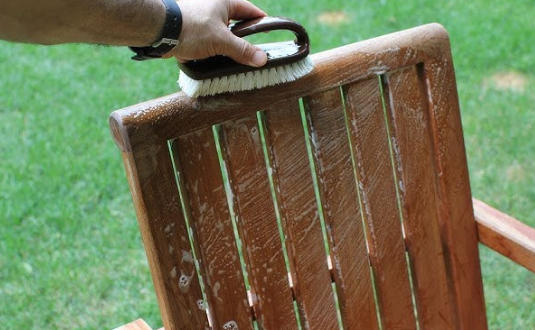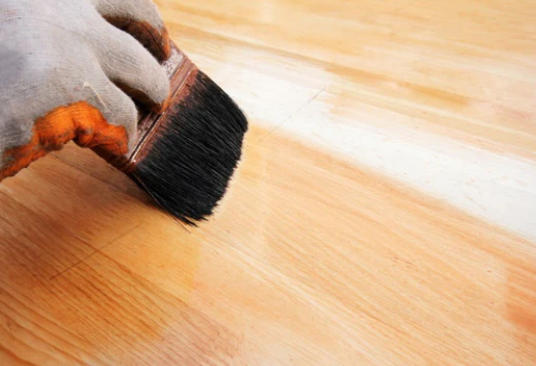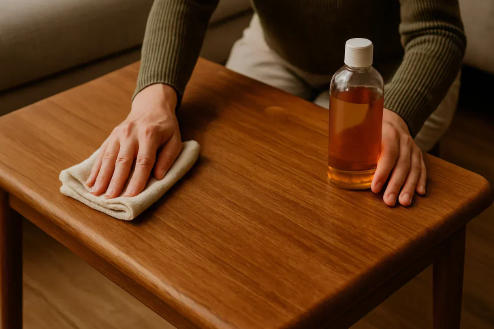










Content Menu
● What Makes Teak Wood Special?
● Understanding the Teak Aging Process
● How Often Should You Clean Teak Wood?
● Step-by-Step Guide: How to Clean Teak Wood
>> Step 1: Gather Cleaning Materials
>> Step 2: Prepare the Work Area
>> Step 3: Pre-Wet the Teak Surface
>> Step 4: Apply a Gentle Cleaning Solution
>> Step 5: Rinse With Clean Water
● How to Deep Clean Heavily Stained or Weathered Teak
>> Applying Teak Cleaner or Brightener
● Applying Teak Oil or Sealer: Finishing and Protecting
>>> How to Apply:
● Eco-Friendly and Homemade Cleaning Alternatives
● Cleaning Advice for Specific Teak Applications
● Common Myths About Teak Care
● Preventative Maintenance Tips
● How to Restore Old or Neglected Teak Furniture
● FAQs
>> 1. How often should I clean outdoor teak furniture?
>> 2. Can I use bleach to clean teak wood?
>> 3. Should I sand teak wood after cleaning?
>> 4. Is sealing teak better than oiling it?
>> 5. Why does teak turn gray?
Teak wood is revered worldwide for its luxurious golden hue, natural durability, and outstanding resistance to moisture and insects. Used in everything from patio furniture to luxury yachts, this tropical hardwood stands the test of time and weather—provided it receives regular, proper care. Cleaning teak isn't difficult, but knowing the right steps ensures your pieces remain beautiful for decades. This guide offers an in-depth look at cleaning and maintaining teak wood, supported by expert tips and practical advice for both beginners and enthusiasts.

Teak (Tectona grandis) is a tropical hardwood primarily found in Southeast Asia, notably in Myanmar, Indonesia, and Thailand. It has several exceptional properties that make it ideal for premium furniture, boat decks, and outdoor architectural features.
- Natural Oils: Teak's natural oils penetrate deep into its fibers, which help repel moisture, prevent rot, and resist insect attacks without requiring chemical preservatives.
- High Silica Content: The high presence of silica in the wood's grain gives it a slight gritty feel and grants remarkable resistance to weather, decay, and environmental stressors.
- Dense Grain Structure: Its tight, overlapping wood grain prevents splintering and bestows structural rigidity, making it ideal for heavy-duty applications.
- Aging Gracefully: Left unfinished, teak develops a beautiful silver-gray patina thanks to the oxidation process—a visual characteristic admired by many homeowners.
These elements explain why teak is so popular for both interior and exterior projects. However, environmental exposure, mildew, and dirt can dull its surface, calling for a reliable cleaning and maintenance routine.
Unlike most hardwoods, teak doesn't rot or degrade quickly, even with minimal care. Over months and years, however, sun and rain cause its original gold-brown color to fade to an elegant, silvery gray. This color change is purely cosmetic and doesn't affect the wood's structural integrity. Whether you prefer the weathered patina or wish to maintain its natural warmth, both goals are achievable with proper cleaning techniques.
When exposed to weather and UV rays, the surface oils of teak oxidize, leading to the graying effect. While some appreciate this mature, rustic aesthetic, others may choose regular cleaning and oiling to keep the original tone vivid.
The frequency depends on environmental conditions and placement:
- Indoor teak: Every 3–6 months, as dust and smudges accumulate slower indoors.
- Outdoor teak: Every 1–3 months, especially if exposed to direct sun, rain, or humidity.
- Marine teak (boat decks): Monthly or after significant saltwater exposure.
Regular, gentle cleaning ensures dirt doesn't build up and prevents the growth of mold or mildew—common in moist environments.
To clean teak wood safely, gather these basic supplies:
- Warm water
- Mild dish soap or a specially formulated wood cleaner
- Soft bristle brush or nonabrasive sponge
- Clean towels or lint-free cloths
- Bucket
- Sandpaper (fine-grit, if resurfacing is needed)
- Teak-specific cleaner or brightener, if deep cleaning
- Teak oil or sealer, if preserving color
If possible, clean teak outdoors or in a well-ventilated space. For large items or tables, place a plastic sheet underneath to protect flooring. Avoid working in direct sunlight, as it can cause cleaning solutions to dry too quickly, leaving spots or streaks.
Begin by wetting the teak thoroughly with a hose (outdoor) or damp cloth (indoor). This opens the pores and loosens any dirt on the surface.
Mix a few drops of mild dish soap with warm water in a bucket. Using your soft bristle brush or sponge, dip into the solution and gently scrub the surface. Always work with the wood grain to protect the surface fibers and avoid scratches.
Thoroughly rinse the surface with fresh water to remove soap or cleaning agents. For outdoor furniture, a hose works well; indoors, use a soaked cloth to wipe away residue.
Pat the wood dry with a clean towel. Leave the item to air-dry completely before using or applying any treatment.
Years of exposure can result in dark stains, mildew, or severe graying. For deeper cleaning, follow these extra steps:
- Choose a commercial teak cleaner for stubborn stains or heavily oxidized surfaces. These cleaners typically come in one- or two-part solutions.
- Apply the product evenly, following package instructions. Most require a soaking period before scrubbing.
- After the recommended dwell time, scrub lightly with a soft brush along the grain.
- Rinse thoroughly with fresh water.
For persistent black spots or ingrained grime, light sanding may be necessary:
- Use fine-grit sandpaper (180–220 grit).
- Sand in the direction of the wood grain—never across it.
- Wipe away dust before proceeding with any oil or sealant.
Important: Only sand teak sparingly. Too much can wear away valuable surface oils and natural density.

Cleaning restores teak's purity, but applying a finishing product preserves its color.
- Pros: Teak oil brings out the rich color, enhances the grain, and provides short-term protection.
- Cons: It wears off in months, requiring frequent reapplication. Over-oiling can lead to sticky or dark buildup.
Teak sealer is a longer-term solution that offers robust UV protection and maintains the golden color much longer.
- Allow the cleaned teak to dry thoroughly (24–48 hours).
- Apply sealer or oil with a lint-free cloth or sponge in a thin, even layer, following the wood grain.
- Remove excess product with a clean, dry cloth after 15–20 minutes.
- Allow to cure as per product instructions—typically a few hours before use.
Tip: Never apply both oil and sealer together. Choose one treatment for optimal results.
Some people prefer green cleaning methods, especially for indoor or food-contact surfaces.
- 1 cup white vinegar
- 1 gallon warm water
- Optional: 2 tbsp mild dish soap
Mix ingredients and apply with a soft cloth or sponge. This solution naturally lifts dirt and odors while being gentle to wood fibers and the environment. Always rinse well and dry after use.
- Dust regularly with a dry, soft cloth.
- Wipe up spills immediately to prevent watermarks.
- For sticky spots or grime, clean with a mild soapy solution, rinse, and dry.
- Clean frequently, especially if exposed to pollen, pollution, or rain.
- Move furniture to a shaded area when cleaning to avoid fast-drying streaks.
- Cover or store indoors during off-seasons for maximum longevity.
- Rinse decks weekly to remove salt buildup.
- Scrub with a dedicated teak cleaner monthly.
- Avoid steel wool or hard brushes, which can gouge the wood.
- Myth 1: Bleach is good for cleaning teak.
Fact: Bleach can permanently damage teak, break down its oils, and dry out the wood.
- Myth 2: High-pressure washing is safe for teak.
Fact: Pressure washers often erode the wood surface and drive water deep into the grain, leading to cracks.
- Myth 3: Sanding is the best method for brightening teak.
Fact: Sanding should only be a last resort because it removes surface oils and thins the wood over time.
- Use coasters, placemats, or tablecloths on indoor tables to prevent stains.
- Keep outdoor furniture covered when not in use.
- Avoid exposing teak to prolonged wetness or pooling water.
- Gently brush away leaves, dirt, or debris regularly.
If you discover old teak furniture in poor condition, restoration is possible:
- First, clean thoroughly with a teak cleaner and mild soap.
- If the wood is extremely gray or rough, a gentle sanding may restore smoothness.
- Rinse and dry the piece completely.
- Optionally, apply a teak brightener to rejuvenate the golden color.
- Finish with oil or sealer.
Restoring old teak can breathe new life into antique pieces and preserve their history.
Teak's legendary beauty and resilience deserve a gentle touch when it comes to cleaning. By steering clear of harsh chemicals and abrasive techniques, using mild soapy water, and periodically applying oil or sealer, your teak wood investments can retain their striking appearance and structural strength for generations. Whether you enjoy the timeless silver-gray patina or prefer the gleaming golden classic finish, attentive cleaning ensures that your teak furniture, decks, and décor remain a source of pride and longevity.

Outdoor teak furniture should be cleaned every 2–3 months to prevent buildup of mold, mildew, and dirt. In coastal or humid climates, monthly cleaning is ideal.
No. Bleach can damage teak's natural oils, fade its color, and dry out its surface. Always use mild soap or a specialized teak cleaner instead.
Light sanding with fine-grit sandpaper (220-grit) is okay for restoring smoothness, especially if the wood feels rough or stained. Avoid aggressive sanding that removes too much surface.
It depends on your preference. Sealers last longer and require less maintenance, while oil enhances grain richness but needs reapplication every few months.
The silver-gray patina is caused by natural oxidation from UV rays and outdoor exposure. It doesn't indicate damage—some people even prefer this vintage look.